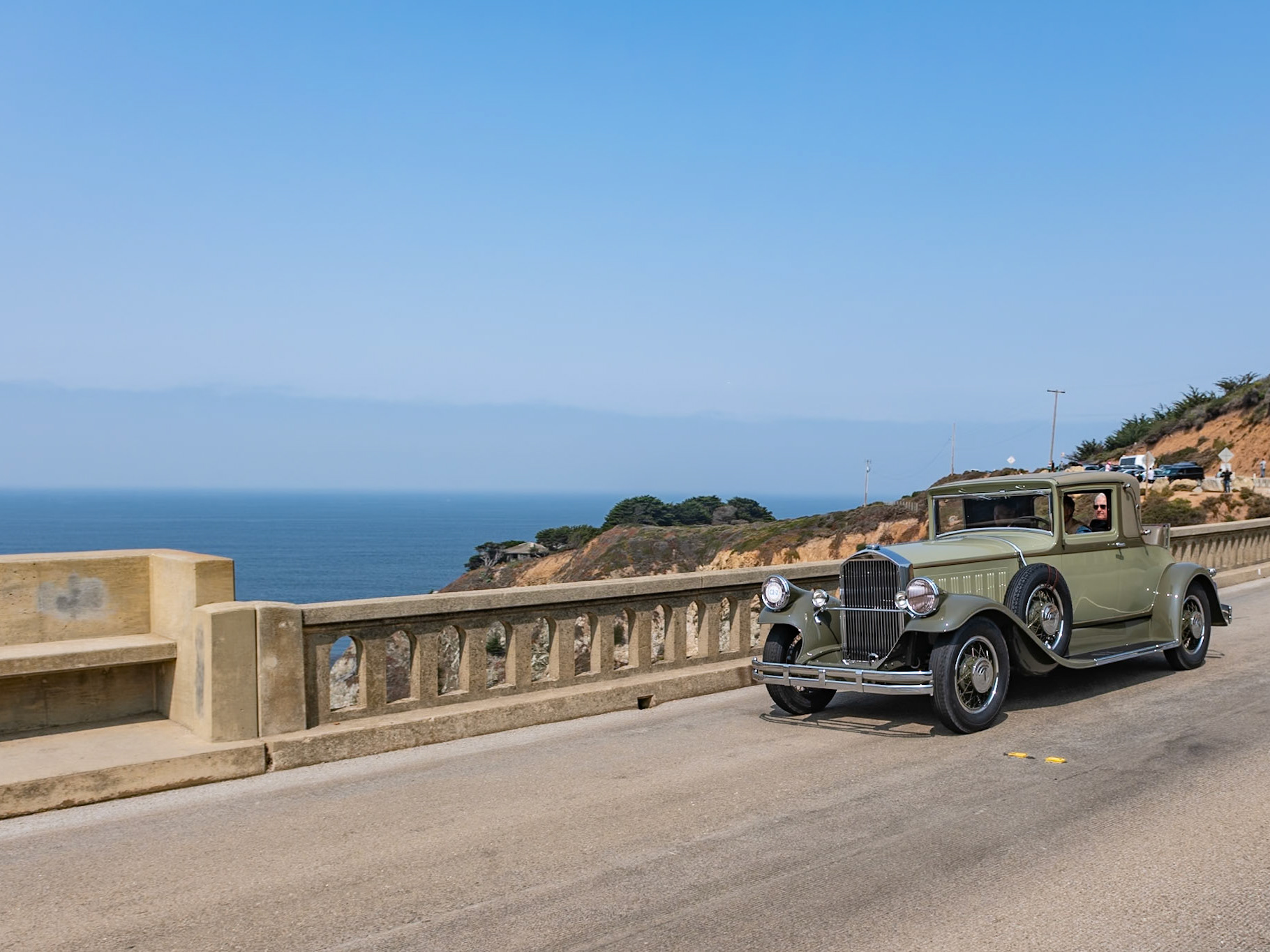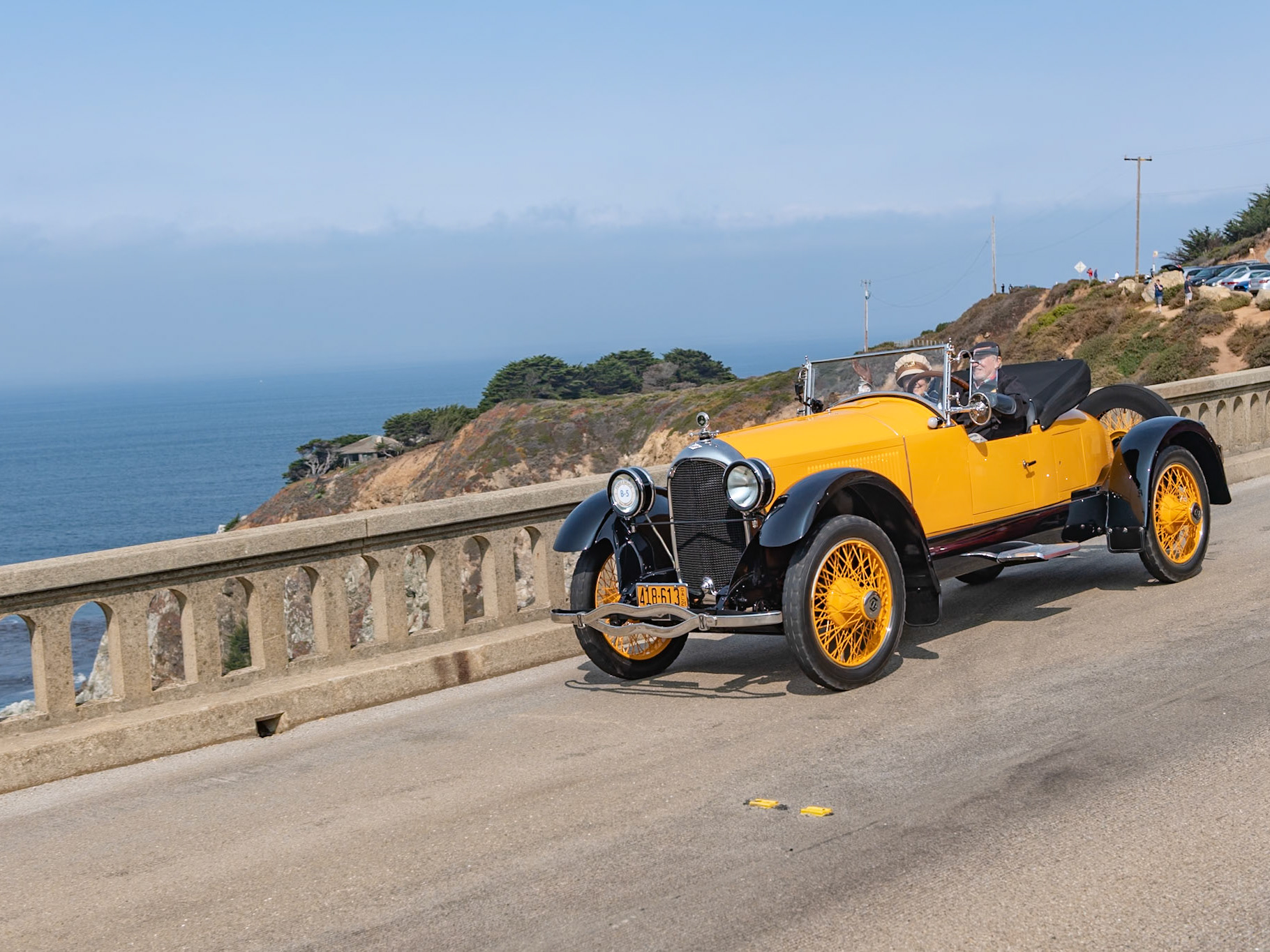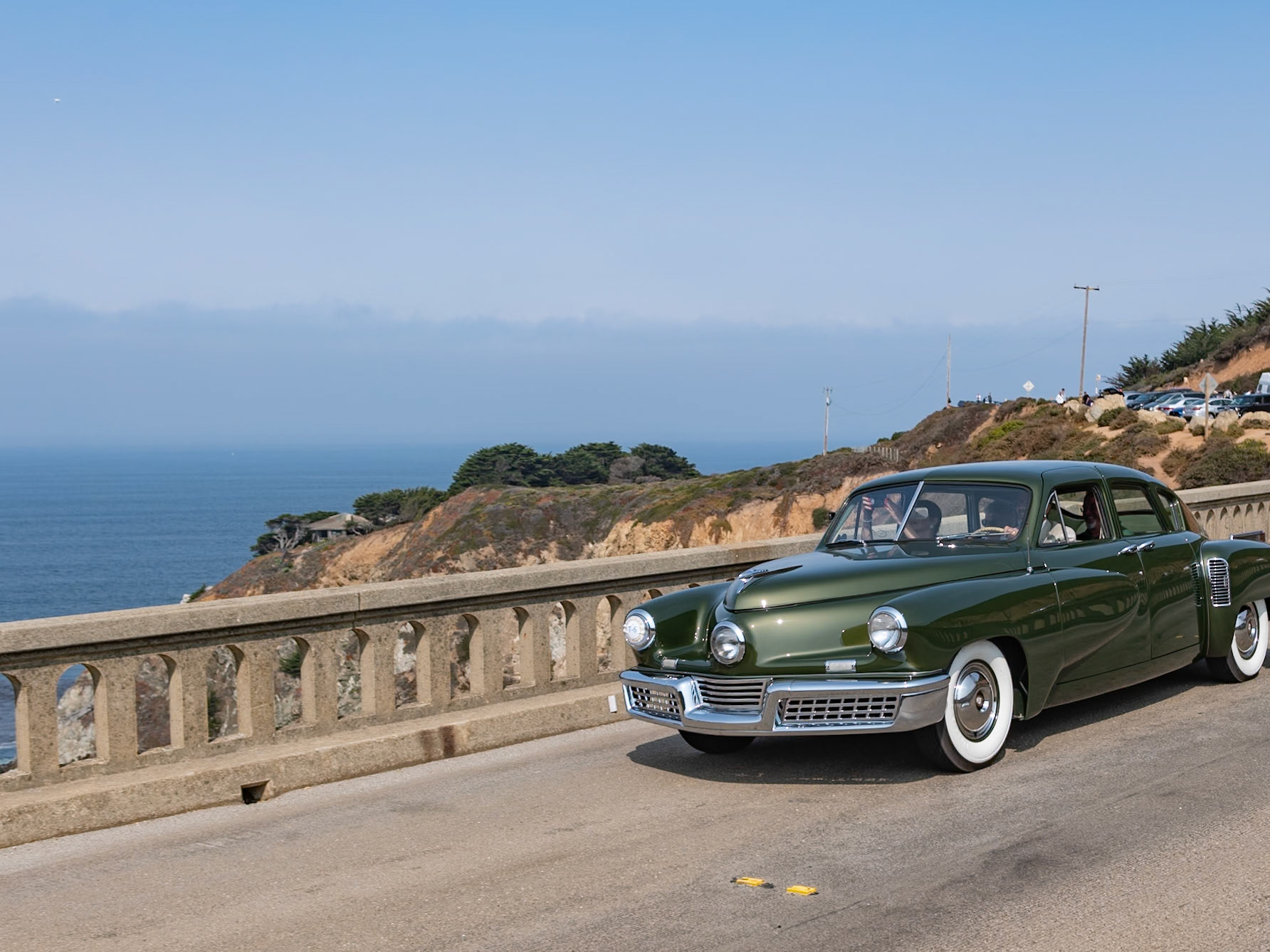
The first Delahaye 135, built in 1935, was powered by a 3.2-liter, 6-cylinder overhead-valve engine with triple carburetors that produced over 100 bhp. A 135SC recorded the marque’s greatest racing success when it was victorious at the 24 Hours of Le Mans in 1938. World War II brought production to a halt, but soon after fighting ceased, Delahaye introduced the new 135M with an engine enlarged to 3.6-liters. This 1946 Delahaye 135M (chassis 800269) was dispatched to the Swiss coachbuilder Graber, who designed this elegant and modern cabriolet body. It is one of just two cars built by Graber in this style. The car was equipped with a Cotal pre-selector gearbox, one of two transmission options at the time. The first owner, who lived in Switzerland, had the engine replaced with the new and more powerful MS engine in 1947. The car remained in Switzerland until 2007. Its current British owner has refreshed the car.

This Delahaye (chassis 818040) is the first of three 235 coupés bodied by Henri Chapron in 1952. It was exhibited on Delahaye’s stand at the 1952 Paris Auto Show. Its more curvaceous rear wings set this car apart from the other two Chapron-bodied 235 coupés. Its early ownership is not known, but in the 1970s it was part of the Seydoux Collection before being sold to Claude Gueveler, a member of the Delahaye Club. Later, it was registered in Monaco. With its 150 bhp 6-cylinder engine, CotaI electromagnetic gearbox, unique haute couture bodywork and luxury finish, this unique 235 Coupé is one of the last of the great Delahayes.

Delahaye’s signature Type 135 was introduced at the 1935 Paris Auto Salon. All Delahayes were bodied by independent coachbuilders and some of the most flamboyant designs were by Joseph Figoni and Ovidio Falaschi. This fabulous example of the French coachbuilder’s art, often called the Narval or “Narwhal” design, was built on a Delahaye 135 M chassis and debuted at the 1946 Paris Auto Salon. It is one of just seven similar cars built by Figoni & Falaschi. The finished car was sent to New York importer Max Hoffman for a Dr. Scheir. In 1951 it was sold to Mark Deitsch, president of Prima, the footwear company, which featured the car prominently in its advertising, earning the car the nickname “Cover Girl.” The car later found its way to the Hata Museum in Japan. The current owner acquired the car in 2014 and has just had it restored.

The first Delahaye 135, built in 1935, was powered by a 3.2-liter, 6-cylinder overhead-valve engine with triple carburetors that produced over 100 bhp. A 135SC recorded the marque’s greatest racing success when it was victorious at the 24 Hours of Le Mans in 1938. World War II brought production to a halt, but soon after fighting ceased, Delahaye introduced the new 135M with an engine enlarged to 3.6-liters. This 1946 Delahaye 135M (chassis 800269) was dispatched to the Swiss coachbuilder Graber, who designed this elegant and modern cabriolet body. It is one of just two cars built by Graber in this style. The car was equipped with a Cotal pre-selector gearbox, one of two transmission options at the time. The first owner, who lived in Switzerland, had the engine replaced with the new and more powerful MS engine in 1947. The car remained in Switzerland until 2007. Its current British owner has refreshed the car.

The Delahaye 135 is an important French automobile, bridging the prewar and postwar periods of engineering. The 135 M boasted a brand-new chassis with the prewar 3.6-liter, 6-cylinder engine first seen in the Delahaye Type 138. The 135 M continued to be available alongside the newer Delahaye 235 until the demise of the company in 1954. This 135 M cabriolet (chassis 801221) was bodied by Alphonse Guilloré, a small coachbuilder from the Courbevoie-sur-Seine suburb of Paris. Its subtle lines create a balance between the extravagant work of Jacques Saoutchik and the more restrained designs of Henri Chapron. The early history of this car is unknown, but by the early 1960s it was owned by designer Brooks Stevens and displayed in his museum in Mequon, Wisconsin. Later the car was sold to Richard Adatto, who restored it for the 1984 Pebble Beach Concours, where it was named First in Class. The Delahaye then completed the Monte Carlo Rallye Historique in 1985. It was sold to its current owner in 2016 and has now been freshly restored.

The Delahaye 135 is an important French automobile, bridging the prewar and postwar periods of engineering. The 135 M boasted a brand-new chassis with the prewar 3.6-liter, 6-cylinder engine first seen in the Delahaye Type 138. The 135 M continued to be available alongside the newer Delahaye 235 until the demise of the company in 1954. This 135 M cabriolet (chassis 801221) was bodied by Alphonse Guilloré, a small coachbuilder from the Courbevoie-sur-Seine suburb of Paris. Its subtle lines create a balance between the extravagant work of Jacques Saoutchik and the more restrained designs of Henri Chapron. The early history of this car is unknown, but by the early 1960s it was owned by designer Brooks Stevens and displayed in his museum in Mequon, Wisconsin. Later the car was sold to Richard Adatto, who restored it for the 1984 Pebble Beach Concours, where it was named First in Class. The Delahaye then completed the Monte Carlo Rallye Historique in 1985. It was sold to its current owner in 2016 and has now been freshly restored.

The Delahaye 135 is an important French automobile, bridging the prewar and postwar periods of engineering. The 135 M boasted a brand-new chassis with the prewar 3.6-liter, 6-cylinder engine first seen in the Delahaye Type 138. The 135 M continued to be available alongside the newer Delahaye 235 until the demise of the company in 1954. This 135 M cabriolet (chassis 801221) was bodied by Alphonse Guilloré, a small coachbuilder from the Courbevoie-sur-Seine suburb of Paris. Its subtle lines create a balance between the extravagant work of Jacques Saoutchik and the more restrained designs of Henri Chapron. The early history of this car is unknown, but by the early 1960s it was owned by designer Brooks Stevens and displayed in his museum in Mequon, Wisconsin. Later the car was sold to Richard Adatto, who restored it for the 1984 Pebble Beach Concours, where it was named First in Class. The Delahaye then completed the Monte Carlo Rallye Historique in 1985. It was sold to its current owner in 2016 and has now been freshly restored.

This unusual Delahaye 135 M (chassis 49315) is one of only two such Delahayes with Roadster bodies built by the Carlton Carriage Company of London. Carlton was well known for its open bodywork on many different European chassis throughout the 1920s and ’30s. This car’s first owner was amateur race driver Joe Fry, a member of the Fry’s Chocolate Company family. He competed with the Delahaye in many prewar sprints and hill climbs. The car remained in his ownership until his untimely death in July 1950 while practicing for the Blandford Hill Climb. Subsequent owners also campaigned the car in England, then it was purchased by collector Nick Harley and taken to the South of France. He restored the car before selling it to its current owner in 2017.

This unusual Delahaye 135 M (chassis 49315) is one of only two such Delahayes with Roadster bodies built by the Carlton Carriage Company of London. Carlton was well known for its open bodywork on many different European chassis throughout the 1920s and ’30s. This car’s first owner was amateur race driver Joe Fry, a member of the Fry’s Chocolate Company family. He competed with the Delahaye in many prewar sprints and hill climbs. The car remained in his ownership until his untimely death in July 1950 while practicing for the Blandford Hill Climb. Subsequent owners also campaigned the car in England, then it was purchased by collector Nick Harley and taken to the South of France. He restored the car before selling it to its current owner in 2017.

The Delahaye 135 M (Modifie) was based on the original Delahaye 135 first shown in 1935. Combining luxurious bodywork with Delahaye’s race-winning engineering, the Delahaye 135 M is one of the most desirable cars from the prewar era. This 1937 Delahaye 135 M Convertible Coupé (chassis 48700) is from the French Carrosserie Henri Chapron. Built on Delahaye’s shorter competition chassis, it has a 95-hp 3.5-liter engine fitted with triple Solex carburetors. The sporty body with its sharply raked one-piece windshield sits low to the ground and features beautifully sculpted teardrop fenders accented by round vents on the side of the hood and a chrome beltline moulding that extends from the radiator surround back through the doors before falling smoothly off at the tail. The car has just been restored by its current owner.

The Delahaye 135 M (Modifie) was based on the original Delahaye 135 first shown in 1935. Combining luxurious bodywork with Delahaye’s race-winning engineering, the Delahaye 135 M is one of the most desirable cars from the prewar era. This 1937 Delahaye 135 M Convertible Coupé (chassis 48700) is from the French Carrosserie Henri Chapron. Built on Delahaye’s shorter competition chassis, it has a 95-hp 3.5-liter engine fitted with triple Solex carburetors. The sporty body with its sharply raked one-piece windshield sits low to the ground and features beautifully sculpted teardrop fenders accented by round vents on the side of the hood and a chrome beltline moulding that extends from the radiator surround back through the doors before falling smoothly off at the tail. The car has just been restored by its current owner.

The Delahaye 135 M (Modifie) was based on the original Delahaye 135 first shown in 1935. Combining luxurious bodywork with Delahaye’s race-winning engineering, the Delahaye 135 M is one of the most desirable cars from the prewar era. This 1937 Delahaye 135 M Convertible Coupé (chassis 48700) is from the French Carrosserie Henri Chapron. Built on Delahaye’s shorter competition chassis, it has a 95-hp 3.5-liter engine fitted with triple Solex carburetors. The sporty body with its sharply raked one-piece windshield sits low to the ground and features beautifully sculpted teardrop fenders accented by round vents on the side of the hood and a chrome beltline moulding that extends from the radiator surround back through the doors before falling smoothly off at the tail. The car has just been restored by its current owner.

This unusual Delahaye 135 M (chassis 49315) is one of only two such Delahayes with Roadster bodies built by the Carlton Carriage Company of London. Carlton was well known for its open bodywork on many different European chassis throughout the 1920s and ’30s. This car’s first owner was amateur race driver Joe Fry, a member of the Fry’s Chocolate Company family. He competed with the Delahaye in many prewar sprints and hill climbs. The car remained in his ownership until his untimely death in July 1950 while practicing for the Blandford Hill Climb. Subsequent owners also campaigned the car in England, then it was purchased by collector Nick Harley and taken to the South of France. He restored the car before selling it to its current owner in 2017.

The Delahaye 135 is an important French automobile, bridging the prewar and postwar periods of engineering. The 135 M boasted a brand-new chassis with the prewar 3.6-liter, 6-cylinder engine first seen in the Delahaye Type 138. The 135 M continued to be available alongside the newer Delahaye 235 until the demise of the company in 1954. This 135 M cabriolet (chassis 801221) was bodied by Alphonse Guilloré, a small coachbuilder from the Courbevoie-sur-Seine suburb of Paris. Its subtle lines create a balance between the extravagant work of Jacques Saoutchik and the more restrained designs of Henri Chapron. The early history of this car is unknown, but by the early 1960s it was owned by designer Brooks Stevens and displayed in his museum in Mequon, Wisconsin. Later the car was sold to Richard Adatto, who restored it for the 1984 Pebble Beach Concours, where it was named First in Class. The Delahaye then completed the Monte Carlo Rallye Historique in 1985. It was sold to its current owner in 2016 and has now been freshly restored.























